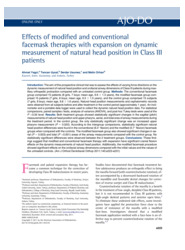Effects of modified and conventional facemask therapies with expansion on dynamic measurement of natural head position in Class III patients
-
Eser Sahibi
TANCAN UYSAL
-
Tür
Makale
- Yayın Tarihi 2011
- DOI Numarası 10.1016/j.ajodo.2011.05.018
-
Yayıncı
American Journal of Orthodontics and Dentofacial Orthopedics
- Tek Biçim Adres Http://hdl.handle.net/11469/177
-
Konu Başlıkları
Natural head position
Conventional facemask therapies
Introduction: The aim of this prospective clinical trial was to assess the effects of varying force directions on the
dynamic measurement of natural head position and orofacial airway dimensions of Class III patients during maxillary
orthopedic protraction compared with an untreated control group. Methods: The conventional facemask
group comprised 15 patients (8 girls, 7 boys; mean age, 9.6 6 1.3 years), the modified facemask group comprised
15 patients (7 girls, 8 boys; mean age, 9.5 6 1.5 years), and the control group comprised 15 subjects
(7 girls, 8 boys; mean age, 9.8 6 1.6 years). Natural head position measurements and cephalometric records
were obtained from all subjects before and after treatment or the control period (approximately 1 year). An inclinometer
and a portable data logger were used to collect the dynamic natural head position data. For statistical
comparisons, paired samples t tests, analysis of variance (ANOVA), and post-hoc Tukey tests were used at the
P\0.05 level. Results: Both treatment groups showed statistically significant changes in the sagittal (pitch)
measurements of natural head position and upper pharynx, aerial, and total area of airway measurements during
the treatment period. In the control group, the only statistically significant change was an increased upper
pharynx measurement (P 5 0.020). According to the intergroup comparisons, statistically significant natural
head position differences were found in the conventional (6.4 flexion) and the modified (5.7 flexion) facemask
groups when compared with the controls. The modified facemask group also showed significant changes in aerial
(P 5 0.003) and total (P\0.001) areas of the airway measurements compared with the control group. No
statistically significant differences were observed between the 2 treatment groups. Conclusions: These findings
suggest that modified and conventional facemask therapy with expansion have significant cranial flexion
effects on the dynamic measurements of natural head position. Additionally, the modified facemask procedure
showed significant effects on the orofacial airway dimensions compared with the initial values and the values of
the untreated controls.


 Tam Metin
Tam Metin

